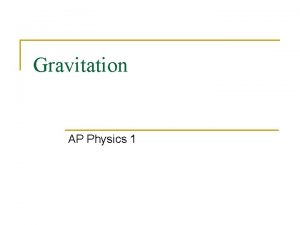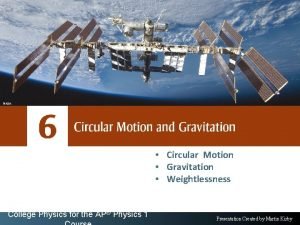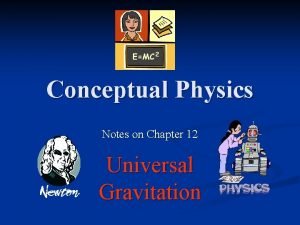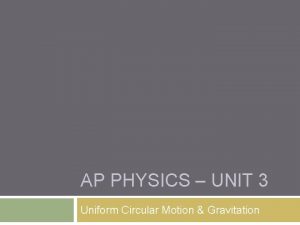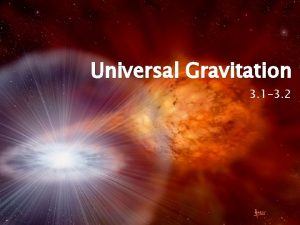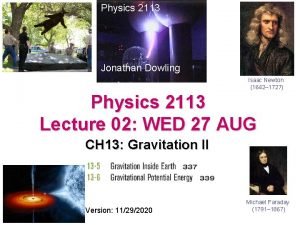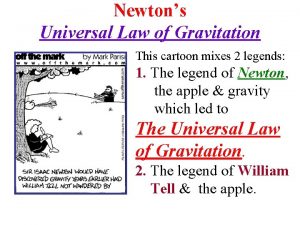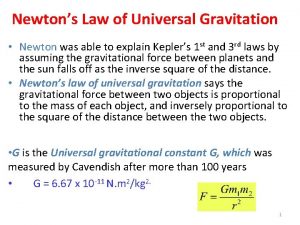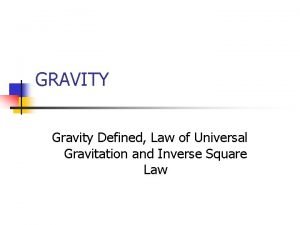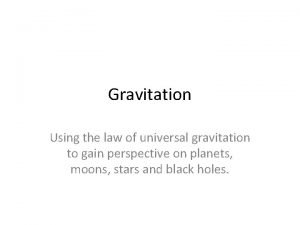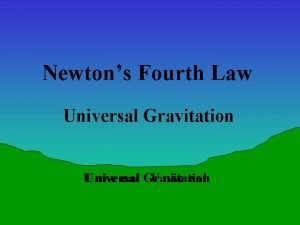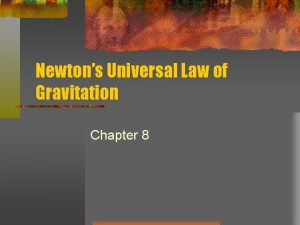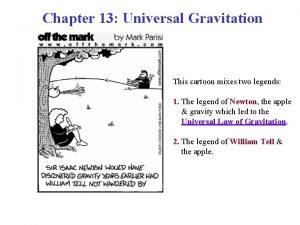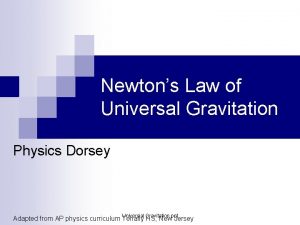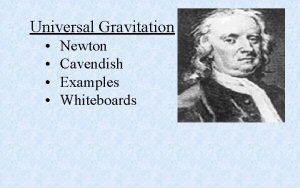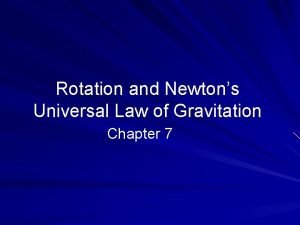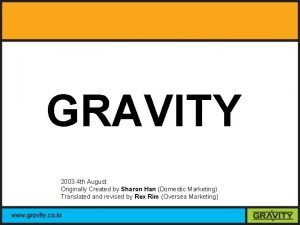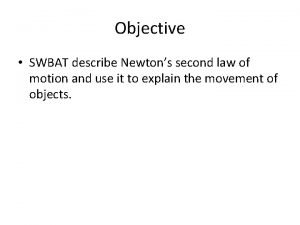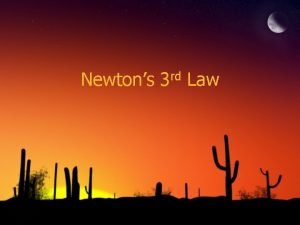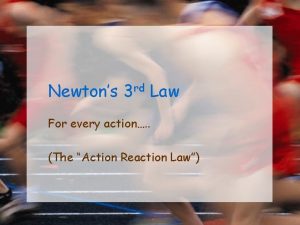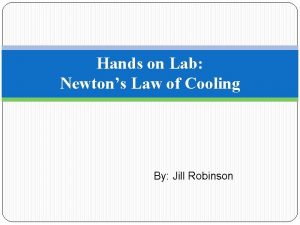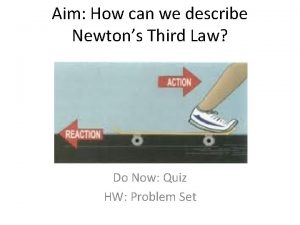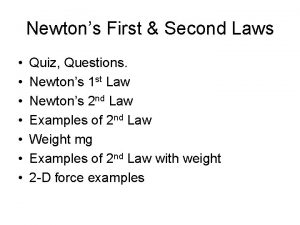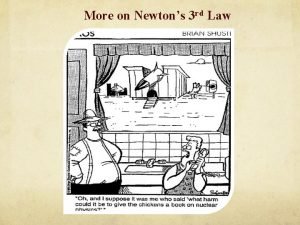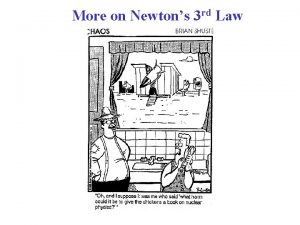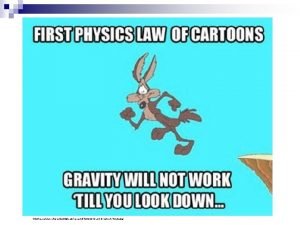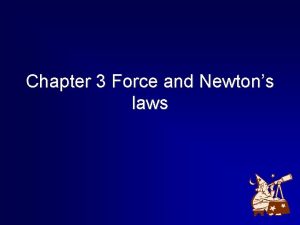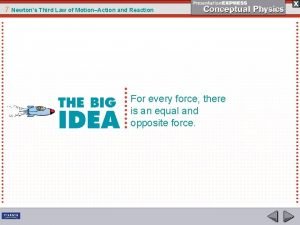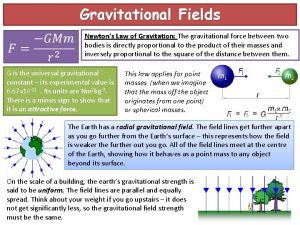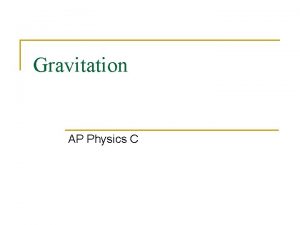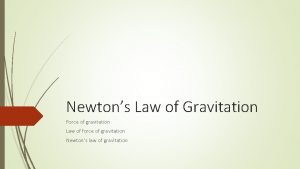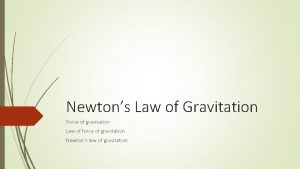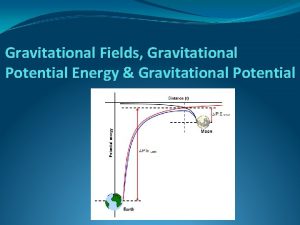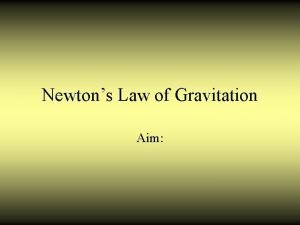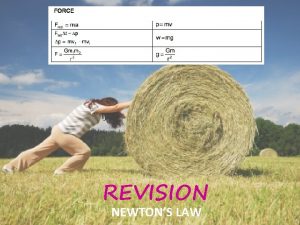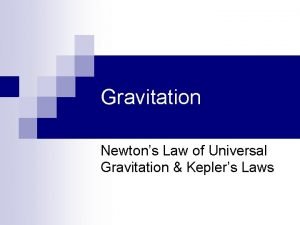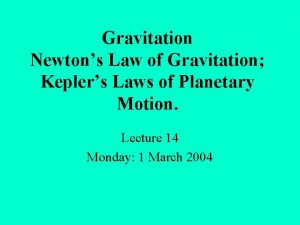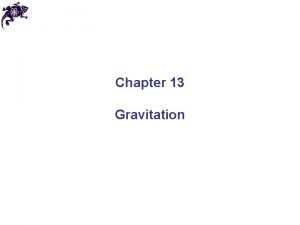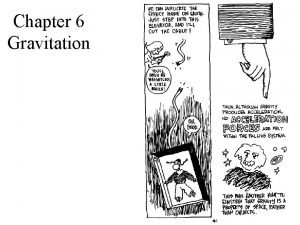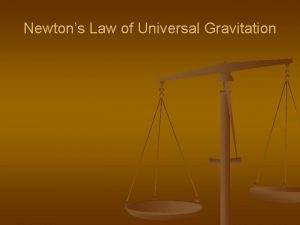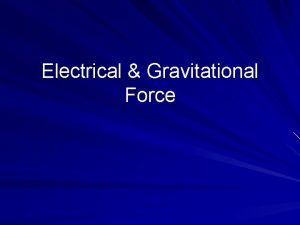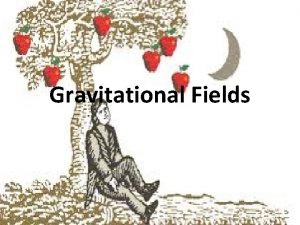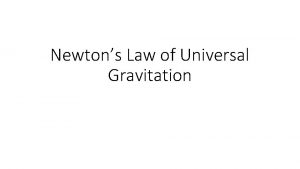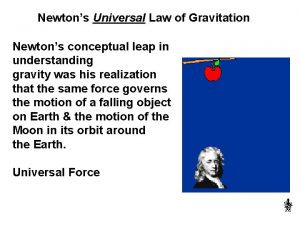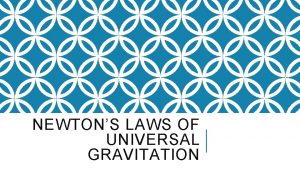Newtons Law of Gravitation AH Physics Gravitational field










































- Slides: 42

Newton’s Law of Gravitation AH Physics • Gravitational field strength • Gravitational potential and gravitational potential energy • Escape velocity and their associated relationships.

What is Gravity? – Higher revision �Gravity is an invisible force of attraction between objects that have mass. �Gravity is a very weak force and therefore is only noticeable when the mass of an object is very big �A Gravitational field is an invisible force field around a mass. �Einstein revised our ideas of gravity in his General Theory of Relativity

Gravity on Earth �The Earths gravitational field strength (g) is 9. 8 Nkg-1 at sea level. �This means that the Earth “attracts” each kilogram of mass with a force of 9. 8 N. �Gravitational field strength (g) is different on other planets.

Newton’s Law of Gravitation �Issac Newton (1643 -1727) thought that there must be a single equation that links the masses of two objects , the distance between them and the force of Gravity between them. �He considered that this force must increase as the masses (M and m) increase and as the distance (r) between them decreases.

Newtons Law of Gravitation (Higher Revision) F = Gravitational force of attraction (N) G = Newtons Gravitational constant m 1 = mass of object 1 (kg) m 2 = mass of object 2 (kg) r = distance between the centre of the 2 masses (m) The constant in this equation is called the Universal Gravitational constant and is 6. 67 x 10 -11 Nm-2 kg-2 (Newton died before this number was found!!) Veritasium - Gravity & Newtons 3 rd Law. (4: 37)

Nevil Maskelyne's Schiehallion experiment Maskelyne was Astronomer Royal and conducted this experiment to measure the mean density, and hence the mass, of the Earth. Schiehallion experiment was conducted in the summer of 1774. The deflection of a pendulum on each side of the mountain was measured astronomically, and samples of the mountain's rock densities were used alongside the symmetrical, near conical shape of the mountain in the calculations. Arthur's Seat, the site of Henry James' 1856 experiment.

Cavendish Boys experiment The Cavendish experiment, performed in 1797– 1798 by British scientist Henry Cavendish, was the first experiment to measure the force of gravity between masses in the laboratory and the first to yield accurate values for the gravitational constant. He got a value of 6. 7 x 10 -11 Nm 2 kg-2

Cavendish experiment �This has been improved and refined over the years… in fact you can now get…. . A usb version

Cavendish - Boys determination of G

Examples � 1. 2 oil tankers each of mass 2. 6 x 108 kg are docked 40 m from each other. Calculate the gravitational force of attraction between them. � 2 What is the gravitational force of attraction between two 60 kg students sitting 0. 8 m apart � 3 What is the force of attraction between the Earth and the moon mass of the Earth : 6 x 1024 kg mass of the moon : 7. 3 x 1022 kg mean Earth / moon radius : 3. 84 x 108 m.

Progressive Questions 84 -86 page 20. Extension questions book page 22 Qs 2 -4.

Gravitational Field Strength 'g' – derivation NO LONGER necessary �Since gravitational field strength is “the force per unit mass”……… G =Newtons Universal constant of gravitation 6. 67 x 10 -11 Nm 2 kg-2 M = mass of planet (kg) r = radius of planet (m) Note: If a question gives you the height above a planet, remember to add on the radius of the planet to get the total ‘r’.

Calculating “g” on Earth. �G = 6. 67 x 10 -11 Nm-2 kg-2 �Mass of the Earth = 5. 972 x 1024 kg �Radius of the Earth = 6371 km This is the Earths Gravitational field strength at the surface: 9. 8 Nkg-1

Gravity & Distance The further away you go from the Earth, the less the force of Gravity becomes. �

examples a) Calculate ‘g’ on the surface of the moon b) Calculate ‘g’ at the top of mount Everest (height above Earth = 8, 850 m) c) Calculate ‘g’ at the orbit of the International Space Station (ISS) (height of orbit above Earth surface = 400 km) d) Where will the value for Earth ‘g’ be zero? a) 1. 7 Nkg-1 b) 9. 7 Nkg-1 c) 8. 7 Nkg-1 d) At infinity

Progressive Questions 91 -94 page 21.

Period of Satellite motion The time if takes for a satellite to orbit the Earth only depends on: a) The height above the Earths surface b) The force due to gravity By choosing heights carefully satellites can be placed into a geostationary orbit above the equator. This means they take 24 hours to orbit the Earth and appear to stay in the same spot in the sky.

Satellite motion – back to central force! �In satellite motion the central force is provided by Gravity �From Higher, Newton’s Universal Law of Gravitation states: Therefore: (Tangential speed)2 Radius of orbit From this and v=d/t we can derive a relationship between the period of a satellites motion and it’s distance from the centre of the Earth.

Period of satellite orbit – (not required) This is the tangential speed of any object moving in a circular path Period radius This is often called “Kepler’s 3 rd Law” – Period 2 varies directly with radius 3 Task: Determine the height of a geostationary satellite orbit above the Earth’s surface. (period = 24 hours)

Height of Geostationary Orbit Gravitational constant: 6. 67 x 10 -11 N m 2 kg-2 Mass of Earth: 6. 0 x 1024 kg Geostationary Period: 24 hours But……. . Radius of the Earth is 6. 4 x 106 m So: Height above Earth’s surface = 4. 23 x 107 – 6. 4 x 106 = 3. 6 x 106 m (36, 000 km)

Kinetic Energy �We can also derive an equation for the kinetic energy of any mass in a circular orbit around a planet or star This is not in the course but could be asked as Problem Solving

Gravitational Field Lines page 16 • • Field lines are closer together at point X - the field strength is stronger. At point Z the field strength is zero. The gravitational field is an example of a conservative field. This means the work done in moving a mass between two points in the field is independent of the path taken.

Gravitational Field around two unequal masses • Where is point z, where the field is zero? • What will the field lines look like?

Gravitational Potential NB This is not the same as gravitational potential energy. The gravitational potential at a point is defined as: The work done by external forces in bringing a unit mass from infinity to that point. The gravitational potential at infinity is defined as zero. The potential at other points will therefore always have a negative value. Jkg-1 distance from mass, M NB r not r 2

Derivation of Gravitational Potential (NOT REQUIRED) Work is done moving a mass m, at constant speed, from infinity to a point r from the centre of the Earth. Ew = Force x Distance = Fr But the force changes with distance.

Gravitational potential. The closer you are to the Earth, the more work has to be done to get you out of the Earths gravitational field. It’s a bit like being in a “well”. The deeper you are in the well, the more work you have to do to get out. All values of gravitational potential are negative. You have to do work to get out of the field to a point where the potential is zero. (You have already met this before in Higher Physics where we studied electron energy levels in the hydrogen atom. The energy levels are all negative because the top level is zero!)

Gravitational Potential Gravitational potential V measured in joules per kilogram J kg-1 From this equation you can see that it is only when you get to an infinite distance (r) from the centre of a planet that the gravitational potential falls to zero. A more mathematical (calculus) approach says………. . “As distance tends to infinity , gravitational potential tends to zero. ”

example �Determine the gravitational potential at: �a) the surface of the Earth �b) the surface of the moon a) -6. 3 x 107 J kg-1 b) -2. 9 x 106 J kg-1 (gravitational potential on the moon surface is about 20 times smaller than on Earth’s surface ) G = 6. 67 x 10 -11 N m 2 kg-2

Gravitational Potential Energy From the definition of gravitational potential, V, due to a mass M The gravitational potential energy, EP for a mass m is defined as: EP = V m Gravitational potential energy in joules J

example �The International Space Station (ISS) has a mass 4. 2 x 105 kg of and is in orbit at a height of 400 km above the surface of the Earth. �Determine the gravitational potential energy of the ISS.

A rocket of mass 8. 00 x 105 kg moves away from the Earth at a constant speed. It moves from a distance of 1. 00 x 107 m from the Earth's centre to 1. 5 x 107 m. How much work must its engines do? work done = difference in gravitational potential energy = EB - EA Or work done = mass x difference in gravitational potential = m(VB - VA) NB Always: Final position - Initial position Ep. B = -2. 1 x 1013 J Ep. A= -3. 2 x 1013 J VA = -40. 02 x 106 Jkg-1 Work Done = (3. 2 - 2. 1) x 1013 = 1. 1 x 1013 J VB = -26. 68 x 106 Jkg-1 m(VB - VA) = 1. 1 x 1013 J

Progressive Questions 99 -106 page 23.

Escape velocity. �Objects that are thrown up in the air always come back down again. �Could an object ever be thrown vertically from the Earth’s surface and escape the pull of Earth’s gravity? �In other words could a mass be given enough velocity so that it could theoretically reach a point where the gravitational potential is zero? �If so, what would this velocity be ? �Think about conservation of energy…………. . ∆Ek ∆Ep

Earth escape velocity At infinity, total energy = 0 Ek + E P = 0 � Note: this is for an unpowered mass, ie a tennis ball, not a space rocket or powered vehicle. A space rocket could escape at velocities below this as escape velocity decreases as distance from Earth decreases.

Calculate the escape velocities for an object on the surface of: (a) the moon (radius of the moon = 1. 74 x 106 m, mass = 7. 3 x 1022 kg) (b) an spherical asteroid of density 3000 kgm-3 and radius 1 km.

Total Energy of a Satellite EK + EP The kinetic energy of an object in orbit can easily be found from the following equations: Centripetal force on a satellite: Gravitational force (F) between the planet (mass M) and the satellite (mass m):

To increase the radius of the orbit: • the gravitational potential energy must INCREASE, ie become less negative. • the kinetic energy must DECREASE, ie become less positive. • the total energy must INCREASE, ie become less negative.

Black Holes �A black hole is a massive star that has collapsed into a tiny volume of dense matter that has a gravitational pull that is so great that not even light can escape from it. �Another way of saying this is that the mass of the object is so great and the radius is so small that the escape velocity from the object is greater than the speed of light. The edge of a black hole is called the “Event Horizon” What would the radius of the Earth have to decrease to for it to become a black hole? Answer: 9 mm

Schwarzchild radius �The Schwarzchild radius is defined as: “the radius of a sphere such that, if all the mass of an object were to be compressed within that sphere, the escape velocity from the surface of the sphere would equal the speed of light” The Schwarzchild radius of any mass can be found by rearranging the escape velocity equation and substituting in the speed of light for the escape velocity (c ) a) Calculate the Schwartzchild radius of the sun b) Explain why our sun could never become a black hole. a) 3 km b) Not enough mass

Schwartzchild radius example � Scientists predict that there is a supermassive black hole at the centre of our galaxy. � Observations predict that it has a mass 4. 3 million times that of our sun. (4. 3 x 10 6 solar masses) � Calculate the Schwartzchild radius of the black hole. Note: this is the event horizon of the black hole, not the radius of the collapsed star itself! Its radius is unknown but smaller then the rs

Einstein’s prediction �Albert Einstein first predicted black holes in 1916 with his general theory of relativity. The term "black hole" was coined in 1967 by American astronomer John Wheeler, and the first one was discovered in 1971. There are three types: stellar black holes, supermassive black holes and intermediate black https: //www. space. com/15421 -black-holes-facts-formation-discovery-sdcmp. html holes Brian Cox on Black Holes 4: 21 vsauce 10: 44 Life and death of a black hole 5: 55 … and so on to Einstein’s theory of General Relativity.

But first… Progressive Questions 107 -112 page 24.
 Newton's universal law of gravitation ap physics 1
Newton's universal law of gravitation ap physics 1 Ap physics 1 circular motion and gravitation
Ap physics 1 circular motion and gravitation Conceptual physics chapter 13 universal gravitation
Conceptual physics chapter 13 universal gravitation Unit 3 circular motion and gravitation
Unit 3 circular motion and gravitation Explain newton’s universal law of attraction/gravitation.
Explain newton’s universal law of attraction/gravitation. Gauss law in gravitation
Gauss law in gravitation Gravitational constant
Gravitational constant Newton's laws of universal gravitation
Newton's laws of universal gravitation Newton's law of gravitation
Newton's law of gravitation Gravity
Gravity Tangential speed
Tangential speed Universal gravitation law
Universal gravitation law Universal law of gravitation calculator
Universal law of gravitation calculator Newton's fourth law example
Newton's fourth law example Newton's universal law of gravitation simplified
Newton's universal law of gravitation simplified Chapter 13 universal gravitation
Chapter 13 universal gravitation Law of universal gravitation ppt
Law of universal gravitation ppt Law of universal gravitation kid definition
Law of universal gravitation kid definition State newton's law of gravitation
State newton's law of gravitation Gravitational field ragnarok
Gravitational field ragnarok Gravitational field
Gravitational field Newtons 3 rd law of motion
Newtons 3 rd law of motion Inertia in soccer
Inertia in soccer Describe newtons second law
Describe newtons second law What object has more inertia
What object has more inertia Newtons 3 rd law of motion
Newtons 3 rd law of motion Newtons 3 rd law of motion
Newtons 3 rd law of motion Newton's 3 law
Newton's 3 law Newtons 3 rd law
Newtons 3 rd law What is k in newtons law of cooling
What is k in newtons law of cooling Describe newtons third law
Describe newtons third law Law of thermodynamics in chemistry
Law of thermodynamics in chemistry Newtons 1law
Newtons 1law Newton's third law
Newton's third law Newton's first and second law quiz
Newton's first and second law quiz Newtons 3 rd law of motion
Newtons 3 rd law of motion Newtons 3 rd law
Newtons 3 rd law Every action has an equal and opposite reaction
Every action has an equal and opposite reaction Newtons 3 rd law
Newtons 3 rd law Newtons 3 rd law example
Newtons 3 rd law example Newton's first law meme
Newton's first law meme Section 3 using newtons law
Section 3 using newtons law Newton's third law
Newton's third law
